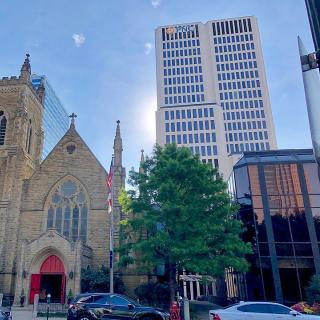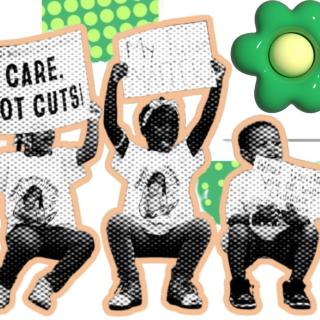In the years 2013-2016, the Columbus Police killed 24 people, 20 of them black.
Mappingpoliceviolence.org lists the names of all Columbus citizens killed by the Columbus Police Department (CPD). Despite only 27.6 percent of Columbus’ population being black, 83.3 percent of all people killed by cops were black (see chart).
Out of the 15 largest U.S. cities, Columbus ranks number one in percentage of police killing black people. (see chart).
Often the police and their allies will excuse the high rates of police violence against black people by claiming they are just trying to stop black-on-black crime, a phrase popularized in the 1980s under Ronald Reagan, as the United States created the world’s largest prison industrial complex. Police shootings of black people are not reflective of high black-on-black crime rates. They are not the result of a police department’s attempt to protect poor communities. A report from mappingpoliceviolence.org points out that there is no relationship between police killing blacks and community violent crime rates.
Nationally, fewer than a third of black people killed by police in the U.S. were suspected of a violent crime or allegedly armed.
The mappingpoliceviolence.org project found that black people were 39 percent of the people killed by the police department in the 100 largest cities despite being only 21 percent of the population in their jurisdiction. The number was even higher for the killing of unarmed people. Fifty percent of the unarmed people were black. An unarmed black person was four times more likely to be killed than an unarmed white person.
Columbus not only reflects but amplifies these national patterns of police shootings of black residents. While a large multi-racial coalition is outraged by the shootings and statistics our city leaders seem to have embraced this killing practice.
Local Black Lives Matter activists were stunned when the Columbus Dispatch reported on February 21, 2017 that the controversial Summer Safety Initiative would be extended as a year-round police tactic.
The Dispatch described it as an “…initiative that blitzes high-crime neighborhoods with police officers.” The Free Press has pointed out that overwhelmingly these officers are white, many are plainclothes and undercover, terrorizing mostly black neighborhoods. They serve more as an occupying army or as a political intelligence unit in an authoritarian regime.
In an obvious gesture of support for Columbus law enforcement, and an offensive brush-off to the Black Lives Matter movement, Columbus Mayor Andy Ginther announced the expansion of one of the nation’s most violent police programs at the Columbus Police Academy at his State of the City address.
All this despite Columbus City Council President Zach Klein promises to the People’s Justice Project during his 2016 campaign for Franklin County Prosecutor that the city would “review” the Summer Safety Initiative following the activists’ shutdown of a City Council meeting.
Ginther’s sole concession to the community was to reiterate an initiative policy that undercover officers are there to conduct “surveillance,” while uniformed officers are supposed to handle the arrests and other activities.
This did not pan out in the June 2016 case of Henry Green. Two undercover officers working in the Linden area in an unmarked vehicle approached 23-year-old Henry Green and a friend walking in their own neighborhood. Witnesses say Green was holding a gun, but there was no reason for the officers to shoot him to death and in doing so, shoot up the neighborhood. The officers claimed they feared for their lives. The autopsy report showed that Columbus police shot Green seven times. Officer Zachary Rosen fired 15 shots and his partner Officer Jason Bare fired seven shots at Green. Houses in the vicinity were full of bullet holes.
Adrienne Hood, Green’s mother, spoke to a police investigator after the shooting. Hood said he seemed surprised when he discovered Henry had no prior record and was not wanted for anything.
According to the Dispatch article “Columbus police tactics questioned in shootout in which Henry Green died,” “In predominantly black neighborhoods, these officers are called ‘jump-out boys.’ It's a term that's been used for decades to describe a tactic police use to fight gang and gun crimes. Many departments, including those in Miami and Los Angeles, have banned the practice of having undercover officers spring from unmarked cars, because they say it makes communities feel less safe.” And the WOSU report “Some Residents Want Summer Policing Program To Go Away” stated that, “A 2015 community survey by police found more than 60 percent of residents think the summer police program does not improve the level of safety in their neighborhood. Seventy percent want police to work harder to create relationships with residents.”
A grand jury refused to indict Officers Bare and Rosen, the two officers responsible for Green’s death, in a March 24 decision. Since then, on April 8, Officer Rosen was caught on video viciously kicking a man already in handcuffs as he lay on the ground. Rosen has been assigned to desk duty. The NAACP is calling for a federal investigation.
Up next will be Officer Brian Mason’s grand jury trial for gunning down 13-year-old Tyre King as he ran away. In his nine years on the force, Mason had already shot a total of four civilians and two died.
Activists are also outraged over the January 14 death of Jaron Thomas after he called a 911 dispatcher saying “I keep hearing these voices.” Thomas, 36, suffered from mental illness and told the dispatcher that he needed an ambulance. Instead, police were sent to his residence. The officers claimed that it sounded like Thomas fell down a flight of stairs just before exiting the door and running outside. Police reported that he began to struggle with officers who then struck him twice on the right side of his face and also kneed him.
Three officers took Thomas into custody awaiting paramedics to arrive. On the way to the hospital Thomas’ heart stopped and he died in the hospital a few days later.
The law firm representing Thomas’ estate, Walton and Brown, issued a statement that said Thomas suffered from “severe brain damage, head contusions, a blood clot near his sternum, at least one broken rib and other injuries.” Many Black Lives Matter activists are skeptical of police accounts that Thomas fell down stairs.
Green, King and Thomas were all black men.
As resentment against the Columbus Police builds in poor and minority communities, concern also mounts over the mystery of the missing dash cam videos. Columbus Police Chief Kim Jacobs confessed on March 1 that an employee of the Columbus Division of Police accidentally deleted about 100,000 dashboard camera video files. Chief Jacobs confirmed at a press conference that most of the files were from 2015 and conceded that one in four of the deleted files was relevant to criminal matters.
The community’s response to Columbus Police shooting and tactics has spawned several local activist groups. Columbus Citizens for Police Review (ColumbusCPR) began two years ago with a petition to initiate a civilian review board of the Columbus Police. The group did not gather enough signatures for a ballot initiative, but currently remains very active holding meetings and training sessions for activists. Standing Up for Racial Justice (SURJ) is a new self-professed group of “white people to act as part of a multi-racial majority for racial justice.” The People’s Justice Project (PJP) is a national movement for community control and police accountability that has taken on police shootings as one of their main issues in Columbus.
These groups and other activists disrupted a Columbus City Council town hall meeting hosted by the Merion Village Association on April 25 at the Reeb Avenue Center. The first words out of the mouth of a demonstrator were “Fire Officer Rosen!” followed by “Fire Officer Bare!” and “Fire Officer Mason!” The remaining demands of the Mayor and City Council were shouted out to the crowd by Adrienne Hood, Green’s mother and other PJP activists. (See sidebar for demands)
While the Columbus City Council has acted with restraint in dealing with demonstrators in Council Chambers and town hall meetings, policing tactics have continued to be aggressive against anti-police violence protesters. SURJ activist Tynan Krakoff organized an anti-police brutality rally last year and appeared to be targeted by police for arrest. The Free Press obtained a dash-cam video that clearly demonstrated that police were tracking him by name and ended up arresting him.
At a large Black Lives Matter protest and march last fall, police on horseback surrounded activists outside the Courthouse downtown. The police surged forward with horses panicking demonstrators and arrested Verbz Vegas claiming he attacked a horse. This year, during a nighttime action near the Ohio Statehouse, anti-Trump protesters sat down in the street. Police excessively sprayed pepper spray and mace into the crowd hitting young children. One activist noted that police followed her and got in her face to spray her, causing her great pain and ruining her contact lens. She had been prominent at many Black Lives Matter actions.
Most recently, on April 26, the Columbus Police shot and killed an unarmed man while attempting to arrest him. Jason Christian who was white and 32-years-old, had outstanding traffic warrants. Columbus Police spokesperson Rick Weiner said that Christian “…did not want to get out of his car, he put the car in gear and tried to get away.”
Those who have traffic tickets are not eligible for the death penalty. It is also legal to open-carry in Ohio, even if you’re a black man in a poor neighborhood. The Supreme Court has ruled that police cannot shoot people running away unless they pose an imminent threat. When people need mental health assistance they should not be beaten to death. And last we looked, the First Amendment still applies to demonstrators, even in Trump’s America. We need to stop the police violence and killings, and hold our officers and elected officials accountable.
The Rate That Police Kill Black People
The rate that police kill black people in the United States’ 15 largest cities, per every million black people:
Columbus 91.9
San Antonio 84
Phoenix 69.1
San Francisco 64.1
Los Angeles 60.5
Indianapolis 58.3
Jacksonville 56.6
Chicago 53.9
Houston 51.4
San Jose 36.4
Dallas 34
Austin 32.9
New York 19.9
Philadelphia 18.6
San Diego 12.1
Police Killing Black People – Ohio’s Major Cities
% Black Population
Columbus 91.9 27.6
Cincinnati 52.9 44.5
Cleveland 28.8 52.4
Toledo 26 26.7
Statistics courtesy of mappingpoliceviolence.org and Black Central, per million black people.
A Response to Injustice in Columbus
8 Demands for Mayor Ginther and Columbus City Council
1.Fire Officer Rosen and Fire Officer Bare. Fire Officer Rosen for the killing of Henry Green and for kicking a handcuffed man in the head. Fire Officer Bare for the killing of Henry Green.
2.Terminate. End the “Community Safety Initiative” which enables officers like Zachary Rosen and Jason Bare to terrorize communities. This undercover policing program was formerly known as the “Summer Safety Initiative.”
3.Fire Officer Mason for the killing of Tyre King.
4.Publicly call for a special prosecutor in the grand jury hearing of Tyre King and the grand jury appeal of Henry Green.
5.Publicly call for an independent investigation in the case of Jaron Thomas and future incidents of police violence.
6.Fire Chief Jacobs for the protection of rogue officers and for the deletion of 100,000 dash-cam/cruiser videos.
7.Negotiate changes to the Collective Bargaining Agreement between the City and the Fraternal Order of Police.
8.Require officers to live in the communities they police. Make the Columbus Police Department (CPD) reflect the demographics of Columbus which is approximately 30% Black. The CPD should be at least 30% Black. The CPD currently has less than 10% of its officers classified as Black.




